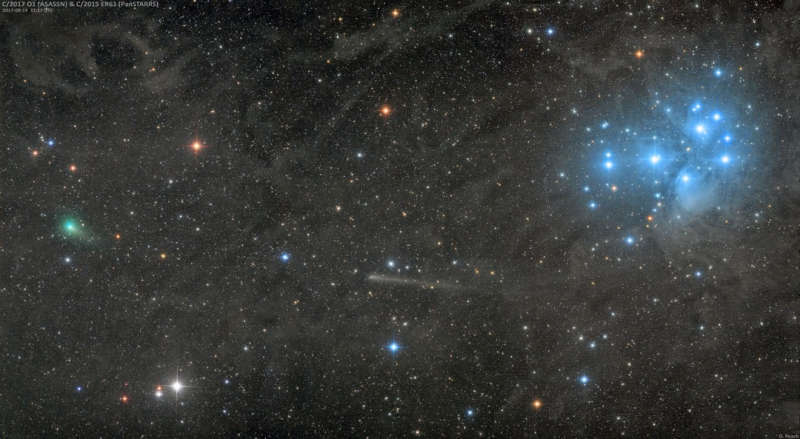
|
Credit & Copyright: Damian Peach
Explanation:
Two unusual spots are on the move near the famous Pleiades star cluster.
Shifting only a small amount per night,
these spots are actually
comets
in our nearby Solar System that by chance wandered
into the field of the
light-years distant stars.
On the far left is comet
C/2017 O1 ASAS-SN, a multi-kilometer
block of evaporating ice sporting a
bright coma of surrounding gas dominated by
green-glowing carbon.
Comet ASAS-SN1
shows a slight tail to its lower right.
Near the frame center is comet
C/2015 ER61 PanSTARRS,
also a giant block of
evaporating ice,
but sporting a rather
long tail to its right.
On the upper right is
the Pleiades, an
open cluster
dominated by bright blue stars illuminating
nearby reflecting dust.
This exposure, taken about two weeks ago,
is so deep that the filamentary interstellar dust can be traced across the
entire field.
The Pleiades is visible to the
unaided
eye, but it should require binoculars to
see the comets.
|
January February March April May June July August September October November December |
| |||||||||||||||||||||||||||||||||||||||||||||||||||||||
NASA Web Site Statements, Warnings, and Disclaimers
NASA Official: Jay Norris. Specific rights apply.
A service of: LHEA at NASA / GSFC
& Michigan Tech. U.
Based on Astronomy Picture
Of the Day
Publications with keywords: comet - pleiades
Publications with words: comet - pleiades
See also:
- APOD: 2025 December 1 Á 3I ATLAS: Tails of an Interstellar Comet
- APOD: 2025 November 25 Á Comet Lemmon and the Milky Way
- 3I/ATLAS: A View from Planet Earth
- APOD: 2025 November 17 Á Comet Lemmons Wandering Tail
- APOD: 2025 September 30 Á Comet Lemmon Brightens
- APOD: 2025 September 29 Á Two Camera Comets in One Sky
- APOD: 2025 September 26 Á A SWAN an ATLAS and Mars
